
Browse an alphabetical list of photographs. These historical images portray people, places, and events before, during, and after World War II and the Holocaust.
<< Previous | Displaying results 151-175 of 226 for "Photo" | Next >>
Scene during a visit by SS officer Theodor Eicke to the Lichtenburg camp in March 1936. Lichtenburg was one of the first concentration camps established in Germany were established soon after Hitler's appointment as chancellor in January 1933. When SS chief leader Heinrich Himmler centralized the administration of the concentration camps and formalized the camp system, he chose SS Lieutenant General Theodor Eicke for the task. Himmler appointed him Inspector of Concentration Camps, a new section of the…
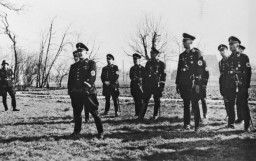
SS officers and German nurses gather during the dedication ceremony of the new SS hospital in Auschwitz, September 1, 1944. Among those pictured are Karl Höcker, Josef Kramer, and SS-Hauptsturmführer Heinrich Schwarz.
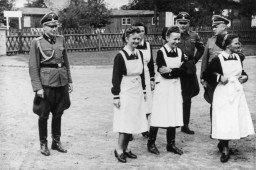
Three SS officers at the Breendonk internment camp: from left, First Lieutenant Hans Kantschuster, Master Sergeant Walter Mueller, and Second Lieutenant Artur Prauss. Breendonk, Belgium, between 1940 and 1944.
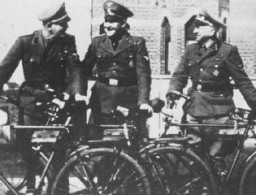
This photograph shows a group of SS officers at Solahütte, the SS retreat outside of Auschwitz. Pictured from left to right: Richard Baer, Dr. Josef Mengele, and Rudolf Höss. From Karl Höcker's photograph album, which includes both documentation of official visits and ceremonies at Auschwitz as well as more personal photographs depicting the many social activities that he and other members of the Auschwitz camp staff enjoyed. These rare images show Nazis singing, hunting, and even trimming a Christmas…
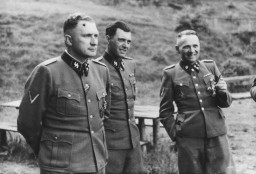
Rare photograph showing Sobibor killing center personnel relaxing and posing, all while implementing the mass murder of at least 167,000 innocent Jews.
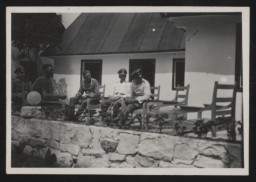
Polish women from the Pawiak and Mokotow prisons in nearby Warsaw are led into the Palmiry forest for execution by SS personnel.The original caption reads: "Their Nazi executioners leading a group of Polish women, according to the information attached to this picture which was just received through Polish sources. Hundreds of cvilians, men, women and even young children are said to be systematically 'eliminated' under the Nazi scheme of things in war-torn Poland". Palmiry Forest, Poland,…
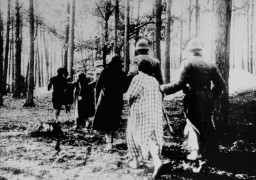
A "sing-along" during a social gathering of the SS hierarchy at Solahütte. The front row consists of (left to right): Karl Höcker, Otto Moll, Rudolf Höss, Richard Baer, Josef Kramer, Franz Hössler, and Josef Mengele. From Höcker's album.
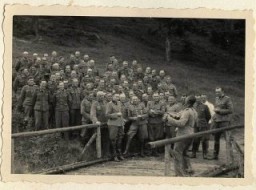
On the day of the vote on the so-called Enabling Act, the Nazi leadership sent SS troops into the makeshift Reichstag building, formerly the Kroll Opera, to intimidate other political parties. Berlin, Germany, March 23, 1933. The Enabling Act allowed the Reich government to issue laws without the consent of Germany’s parliament, laying the foundation for the complete Nazification of German society. The full name of the law was the “Law to Remedy the Distress of the People and the Reich.”
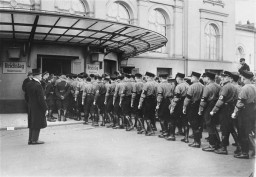
SS troops lead a group of Poles into the forest near Witaniow for execution. Witaniow, Poland, October–November 1939.

SS troops stand at attention for inspection, Germany, 1936-1939. This photo is from an album of SS photographs.
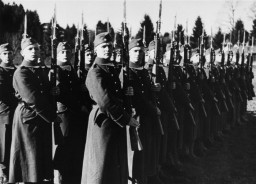
The St. Louis, carrying Jewish refugees from Nazi Germany, arrives in the port of Antwerp after Cuba and the United States denied it landing. Belgium, June 17, 1939.
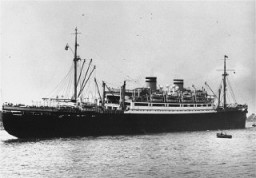
Boarding pass for Dr. Walter Weissler for a voyage on the St. Louis from Hamburg to Havana. When Cuban authorities refused the passengers entry, Weissler returned to France, where he survived in hiding. He died in Paris in 1996. Hamburg, Germany. Date of pass, May 13, 1939.

Passengers on the St. Louis wait to hear whether the Cuban government will permit them to land. Havana, Cuba, between May 27 and June 2, 1939.

Soviet officials view stacked corpses of victims at the Klooga camp. Due to the rapid advance of Soviet forces, the Germans did not have time to burn the corpses. Klooga, Estonia, 1944.
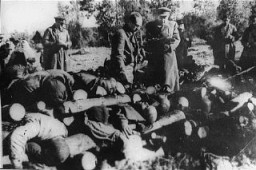
Staff from the Hadamar euthanasia center, including senior physician Adolf Wahlmann (front, left), during their trial. Wiesbaden, Germany, October 8-15, 1945.
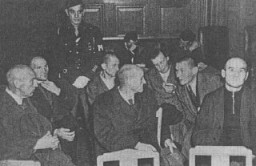
Stateless Jewish refugees at the Mischdorf tent camp along the Slovak-Hungarian border, following the First Vienna Award which gave a sector of southern Slovakia to Hungary. Local Jews were accused of supporting the Hungarian claim, were driven across the border, then back again, then were forced to live for weeks in an open field. November 1938.
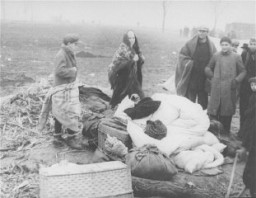
Stephen S. Wise, later to become president of the World Jewish Congress, speaks at an anti-Nazi rally at Madison Square Garden. New York, United States, March 27, 1933.
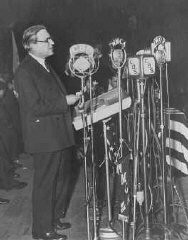
American Zionist leader Rabbi Stephen S. Wise (right) with Bernard Deutsch, president of the American Jewish Congress, before making a protest to President Franklin D. Roosevelt against religious persecution in Germany. New York, United States, March 22, 1933.
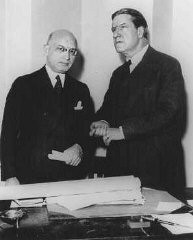
American Jewish Congress president Stephen S. Wise (center right), with Dr. Ignacy Schiper (far left), a Polish Zionist. Warsaw, Poland, 1936.
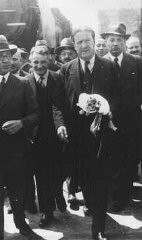
View of the stone quarry in the Gross-Rosen camp, where prisoners were subjected to forced labor. Gross-Rosen, Germany, 1940-1945.
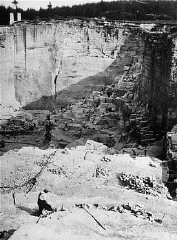
Shortly after the German annexation of Austria, Nazi Storm Troopers stand guard outside a Jewish-owned business. Graffiti painted on the window states: "You Jewish pig may your hands rot off!" Vienna, Austria, March 1938.
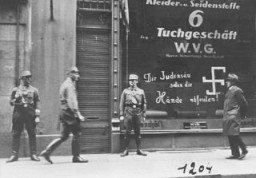
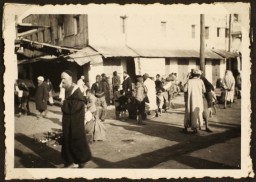
A Jewish family strolls along a street in prewar Kalisz. Poland, May 16, 1935.
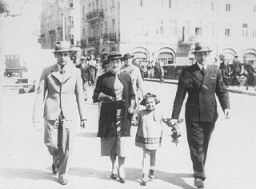
Street scene in the Warsaw ghetto. The sign at left announces: "Soup in the courtyard, first floor, apt. 47." Warsaw, Poland, 1940-1941.
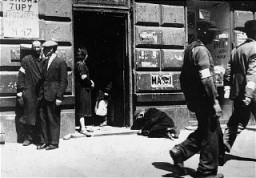
Stall of a street vendor selling old Hebrew books. Warsaw ghetto, Poland, February 1941.
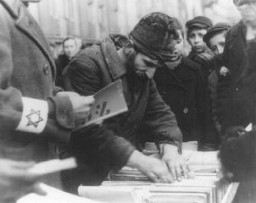
We would like to thank Crown Family Philanthropies, Abe and Ida Cooper Foundation, the Claims Conference, EVZ, and BMF for supporting the ongoing work to create content and resources for the Holocaust Encyclopedia. View the list of donor acknowledgement.